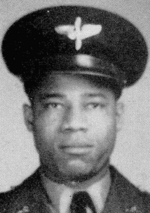Alva Temple facts for kids
Quick facts for kids
Alva Temple
|
|
|---|---|

Alva Temple
|
|
| Birth name | Alva Newte Temple |
| Born | August 5, 1917 Carrollton, Alabama, US |
| Died | August 28, 2004 (aged 87) Columbus, Mississippi, US |
| Buried |
Cook-Temple Memorial Cemetery, Pickensville, Alabama
|
| Allegiance | |
| Service/ |
United States Army Air Force |
| Years of service | 1943–1962 |
| Rank | Lieutenant Colonel |
| Unit | 332nd Fighter Group |
| Awards | Congressional Gold Medal (2007) |
| Alma mater | Alabama A & M University |
| Spouse(s) | Lucille née Grimes |
Lieutenant Colonel Alva Newte Temple (born September 5, 1917 – died August 28, 2004) was an amazing pilot and officer. He served in the U.S. Army Air Forces. He was a combat fighter pilot with the 332nd Fighter Group. This group was famous for its all-African American pilots, known as the Tuskegee Airmen. They were also called the "Red Tails." German pilots even called them “Schwartze Vogelmenschen,” which means "Black Birdmen." Alva Temple was one of the 1,007 pilots who became a Tuskegee Airman.
In 1949, Alva Temple and his team of all-African American pilots won first place. This was at the U.S. Air Force's first-ever "Top Gun" team competition.
Contents
Early Life and Family
Alva Temple was born on September 5, 1917. His family lived in a rural area called Carrollton, Alabama. As a child, he helped his family by picking cotton. This was during a tough time called the Great Depression.
He went to Alabama A&M University. He earned a degree in Agricultural Education. Alva Temple was married to Lucille Grimes Temple for almost 60 years.
Becoming a Tuskegee Airman
When Alva Temple was 24, he finished college. He wanted to become a pilot. But back then, there were unfair rules in the U.S. military. These rules were based on a person's race. Because of this, there were no separate places for black pilots before 1942.
When Temple first tried to join the U.S. Army Air Forces, he was turned away because of his race. But then, the Army Air Forces started the Tuskegee Pilot Cadet program. This program was in Tuskegee, Alabama. Temple applied again and was accepted!
On July 28, 1943, Temple finished his training. He earned his pilot wings and became a 2nd Lieutenant. He was then sent to the 332nd Fighter Group's 99th Pursuit Squadron.
People described Temple as a "reliable, dependable, and calm" pilot. He loved to fly and was always ready for a mission. He knew flying was risky, but he didn't let that stop him. Temple once said, "I felt I could fly if given a chance. A lot of people thought I was crazy. They thought I’d be killed, but I didn’t pay them any attention."
Flying in World War II
During World War II, Temple flew 120 missions. He flew over many countries, including Italy, Germany, and France. He flew a Red-Tailed P-40 and a P-51 Mustang. For his bravery, he earned the Distinguished Flying Cross (United States).
Alva Temple served in the military for 20 years. He was in the United States Army Air Forces and later the United States Air Force (USAF). He retired in 1962 as a Lieutenant Colonel.
Winning the "Top Gun" Competition
In January 1949, the U.S. Air Force decided to hold a competition. It was an aerial weapons competition for different Air Force groups. In May 1949, Alva Temple joined his team from the 332nd Fighter Group. They went to compete in the first "Top Gun" competition. It was held at Las Vegas Air Force Base, which is now Nellis Air Force Base.
This competition was tough and lasted 10 days. It had six different events. These included shooting targets in the air and dropping bombs. Temple's team was amazing and led the competition from start to finish.
Temple's team included First Lieutenant Harry Stewart, Jr. and James H. Harvey. They flew F-47N planes. These planes were a type of Republic P-47 Thunderbolt. Temple and his team won against other Air Force teams. These other teams had much more advanced aircraft.
For many years, the results of this competition were not widely known. The winning trophy was even stored away for 55 years! His teammate, James H. Harvey, later said, "They knew who won, but did not want to recognize us." This shows the challenges they faced.
Awards
- Congressional Gold Medal (2007, given after his death)
After the Military
After retiring from the Air Force in 1962, Temple moved to Mississippi. He owned and ran a Gulf Service station. He also had Temple's BP Stations and Radiator Sales.
He became an important leader in his local community and across the state. He served for seven years as a commissioner for the Mississippi State Department of Natural Resources Committee. Before he passed away, Temple helped create the Alva N. Temple Chapter of Tuskegee Airmen in Columbus, Mississippi.
Death
Alva Temple passed away at his home in Columbus, Mississippi, on August 28, 2004. He is buried in the Cook-Temple Memorial Cemetery in Pickensville, Alabama.
Legacy
In 2008, a road at Columbus AFB was renamed "Alva Temple Road." This was done to honor him.
In 2012, Temple's family gave some of his personal items to a museum. This museum is the R.E. Hunt Museum and Cultural Center. It is located at the former site of R.E. Hunt High School. This was Columbus, Mississippi’s only African American high school until 1971.
See also
- List of Tuskegee Airmen Cadet Pilot Graduation Classes
- List of Tuskegee Airmen
- Military history of African Americans
- Dogfights (TV series)
- Executive Order 9981
- The Tuskegee Airmen (movie)

